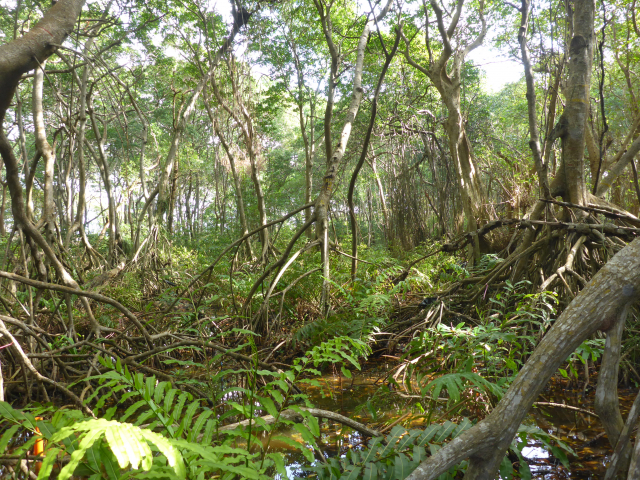15/07/2020 | Each year on 26 July, the ‘International Day for the Conservation of the Mangrove Ecosystem’ is celebrated worldwide. In 2015, the date was adopted by the UNESCO for the first time to draw attention on how important mangrove forests in the tropics are not only for animals and locals, but also for the global climate. At the Leibniz Centre for Tropical Marine Research (ZMT), Professor Martin Zimmer studies these fascinating trees that grow in the salty waters of the tidal zone. In order to protect mangroves worldwide, Zimmer and his colleagues at ZMT have developed the concept of ecosystem design.
Mangrove research is a dirty business. Martin Zimmer often sinks knee-deep into the sludgy ground or wades through muddy water reaching his waist to be able to take the necessary samples from the sediment. Temperatures also make the work challenging. In Bragança in Brazil, for example, temperatures can reach up to 40 degrees in the shade. The region south of the Amazon estuary is one of the places where ZMT’s mangrove ecologist does research.
For protection, Martin Zimmer wears a baseball cap and clothes covering arms and legs, not only because of the sun but also to protect himself from the blood-sucking insects. In this extreme environment, sampling becomes a quite special task. “Heat, dehydration, sweat and mud do not make it easy to handle samples of microorganisms or environmental DNA in a perfectly clean and sterile way,” says Martin Zimmer. He loves to work in the field, often far away from civilisation, to find out how mangroves function as an ecosystem and what is needed to protect them effectively.
Mangroves bind large amounts of carbon dioxide and other climate gases
Across an area of around 15 million hectares, mangrove forests thrive in unique habitats. The approximately 80 different species that exist on Earth grow in the tidal zone or at river estuaries and can live in salt-water-saturated sediments with little oxygen – conditions that would be lethal for most plant species.
Mangrove forests play an important role for humans and animals. Mangroves bind large quantities of carbon dioxide and other greenhouse gases. Overall, researchers estimate that between four and 20 billion tons of carbon are stored in the tidal forests. Mangroves thus contribute significantly to climate protection. The tropical forests shelter the coasts from erosion and storm waves, they provide coastal protection and are home to countless species of fish and crustaceans. Therefore, it is important to protect the mangroves.
Although a recent study with participation of ZMT has shown success in global efforts of mangrove protection and estimates mangrove decline at 0.3 to 0.6 percent per year over the last 20 years, great efforts are still needed to continue this positive trend. Mangrove forests around the world continue to be threatened by aquaculture, agriculture and urban development. A traditional focus of mangrove deforestation is Southeast Asia, where aquaculture facilities and rice fields line extensive coastal zones.
“These new figures are positive, but they do not change the fact that over the past 50 years more than a third of the world's mangrove stocks have been deforested or destroyed,” explains Martin Zimmer.
Ecosystem design to protect mangroves
Often mangrove restoration projects fail because important ecological requirements are ignored. For example, mangroves are planted in locations that are exposed to strong currents or are unsuitable for other reasons. Often, less stress-resistant monocultures are planted or species are introduced that are not indigenous, become invasive and can lead to massive ecological problems.
To protect mangroves, Martin Zimmer has now developed the concept of ecosystem design. The initial aim is to preserve the mangroves' ecosystem services and resources through sustainable management. However, which conservation approaches are implemented and which management measures will be allowed depend on prioritising the needs. “Protection methods do not always meet the needs of all affected population groups, and the corresponding decisions do not always lead to greater sustainability,” says Zimmer. “Ecosystem design takes a proactive approach to this problem.”
In practice, it looks like this: Researchers analyse expectations and needs and develop a concept for the optimal design of the ecosystem in order to safeguard or restore precisely those ecosystem services that have been prioritized.
“This can entail various decisions, such as ensuring that certain areas of the ecosystems are completely protected, partially used, used differently and, above all, purposefully restored after degradation,” says Zimmer. “Thus, humans are at the centre of the ecosystem design approach, not the idea of unspoiled nature.”
Zimmer is well aware that this approach may give rise to concerns of an ethical nature or with regard to prioritising use. The concept of ecosystem design is often criticised by environmentalists because of its active intervention in the species composition of a habitat.
As Martin Zimmer explains: “The associated accusation of acting as a creator, however, does not go far enough: classical restoration also follows this approach, even if it has different objectives. The human cultivation of nature for forestry and agriculture, horticulture or aquaculture has also been an active intervention in natural events for centuries – in contrast to ecosystem design, however, this has been done mostly without considering or taking into account the consequences for our environment and ourselves,” says Zimmer. “Tailor-made systems that sustainably provide what the local community needs may be less species-rich than naturally grown ecosystems,” he adds.
This could be a problem if biodiversity as such is a necessary ecosystem service. “If, for example, biodiversity is an attraction for tourism, ecosystem design in its simple form would not work,” explains the mangrove expert.
All in all, the ecosystem design approach should only provide an impetus. “As soon as the ecosystem is functioning, other species can settle; fish, crabs, birds or monkeys will colonize the mangroves, but also other mangrove species whose seeds are washed up by the tides," says Zimmer. “Even a simply designed mangrove ecosystem can develop towards a naturally grown species-rich system, if this does not counteract the prioritized ecosystem services.”





